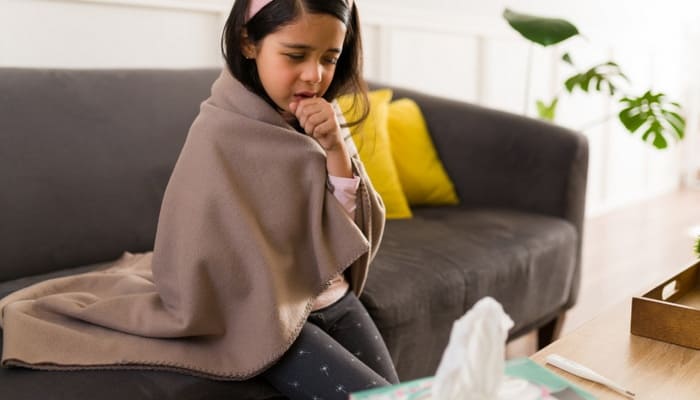Зміст
Flu in a child usually causes concern among parents. Although it is a common condition, its symptoms can be severe. Recognizing the flu, understanding its course and effective treatments are critical to ensuring your child recovers quickly and prevents complications. In the article below, we will explain what to look out for in case of this condition
Types of influenza in children
Flu is a seasonal viral disease. Characterized by a high degree of contagiousness. Infection occurs through airborne droplets as a result of contact with a sick person. Flu in a child, like flu during pregnancy, requires special attention and proper treatment. Is his move always the same? Not necessary. There are three types of influenza virus: A, B and C. The disease is most mild when infected with the type C virus. Type B virus is much more common in children and also has the ability to cause epidemics. In turn, the type A virus is responsible for the most severe cases of the disease, often leading to complications.
Flu in a child – symptoms
It happens that flu symptoms in a child at the initial stage of the disease are confused with a cold. However, there are certain differences that often make it possible to distinguish between the two diseases. First, the onset of influenza is much faster than with a “regular” seasonal infection. Secondly, unlike colds, the flu is usually not accompanied by a runny nose. However, this is not always a strict rule. It happens that the flu manifests itself in different ways: from infections without obvious symptoms to severe and complicated cases of infection. According to the literature, approximately half of those infected, including the youngest, experience typical symptoms, such as:
- heat,
- Strong headache,
- muscle pain,
- dry, suffocating cough,
- General weakness.
Sometimes there may also be symptoms from the digestive system, such as abdominal pain or diarrhea, which often accompany, for example, food allergies in children.
How does the flu affect a child?
The impact of influenza on children depends on many factors. If your baby has been vaccinated against this disease this season, even if he gets sick, the risk of severe illness is low.
The stages of influenza in a child, if the disease proceeds in a “book” manner, can be divided into:
- Incubation period: After infection with the influenza virus, it usually takes 1-4 days before the first symptoms appear. At this time, the child usually does not yet show symptoms of the disease, but he can already infect others,
- Initial symptoms: The first symptoms may resemble a cold, usually they include: a sudden increase in temperature, headache, feeling tired and weak, muscle and joint pain (if you do not know how to recognize the flu in a child, it is worth carrying out appropriate tests, which are currently available in pharmacies)
- Severity of symptoms: Symptoms become more intense in the following days.
- A period of gradual disappearance of symptoms,
- Recovery period: after the acute symptoms of the disease subside, the child needs time for a complete recovery. During this period, you may still experience feelings of fatigue and weakness, which usually last for several days or even several weeks. After returning to full strength, it is worth strengthening the immune system naturally and considering, among other things: what herbs to strengthen the immune system should be used, probiotics or dietary supplements to compensate for possible deficiencies.
How long does the flu last in a child?
In addition to asking about the flu in children, parents also often ask how long the infection lasts. Most symptoms disappear within a few to a dozen days, but coughing and weakness may last up to several weeks. If your child’s flu symptoms become more severe, especially if they have difficulty breathing, have a fever that lasts longer than usual, or their health suddenly worsens, call your doctor as soon as possible. It is especially important to monitor influenza in infants and children 2 to 3 years of age because they are at greater risk for complications.
How to treat flu in a child?
So, how to treat flu in a child? The most important thing is to ensure he gets enough rest and hydration. In addition, it is advisable to use symptomatic drugs that have antipyretic and analgesic effects (for example, paracetamol). The dose and frequency of administration should be adjusted based on the age and weight of the child. Increasingly, doctors are prescribing antiviral drugs that “act” directly on the cause of the infection. However, their use is justified when we are dealing with the first stage of the disease, when, for example, the presence of the virus is confirmed by a blood test or a pharmacy test after contact with an infected person.
Home remedies for flu in children
If a child has the flu, home treatment may include natural methods of relieving symptoms, such as linden or raspberry infusions, which have a diaphoretic effect and thus reduce fever. They will also be useful whenever we are looking for answers to the question of which herbs are best for colds.
Cool compresses also have an effect on reducing elevated body temperature. It is important to remember that although the flu in a child should require bed rest, the body should not overheat. What about cough? Is there a home way to deal with this flu symptom? It turns out that, for example, homemade onion syrup or honey, which can be used in combination with milk, can help here. However, you should be sure that the child is not allergic to bee products (it is not recommended to give them to children under 1 year of age).
Undoubtedly, it is worth taking care of a nutritious, easily digestible diet. You shouldn’t worry if your child loses their appetite because of the flu. This happens relatively often and is a consequence of the baby’s general bad mood. Therefore, you should choose dishes such as purée soups, oatmeal, jellies, or compotes.
You should also not stop taking vitamin D or omega acids, of which hemp oil or black seed oil for children may be a good source. The latter is also recommended as a natural traditional remedy for candida infections in children.
Complications of influenza in children
If your child develops serious symptoms or suspects complications from the flu, contact their doctor. In practice, most parents of children suffering from this infection turn to a specialist, since a high temperature combined with muscle pain and a constant cough is a cause for concern. It is also worth paying attention to the characteristics of the course of the disease in different age groups. The flu in a 2-year-old child can be much more dangerous than, for example, the flu in a 6-year-old.
The most common complications of influenza in children include pneumonia, bronchitis, otitis media, and in rare cases, more serious complications such as myocarditis. All of the above may require hospital treatment under close medical supervision.








